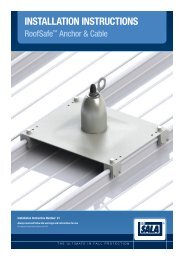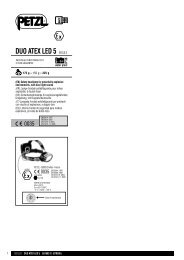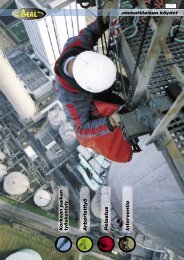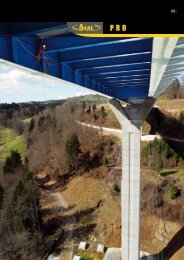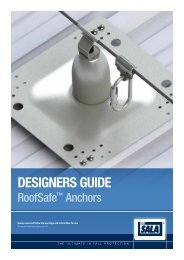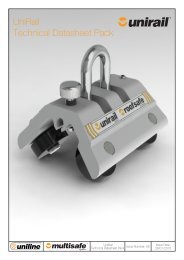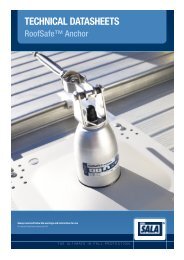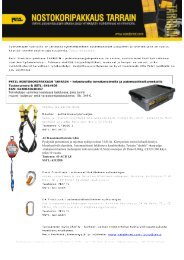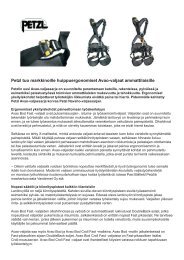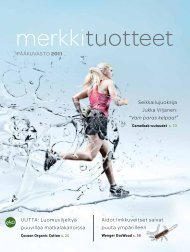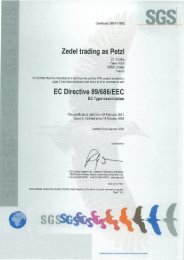EUROPEAN STANDARDS - Vandernet
EUROPEAN STANDARDS - Vandernet
EUROPEAN STANDARDS - Vandernet
You also want an ePaper? Increase the reach of your titles
YUMPU automatically turns print PDFs into web optimized ePapers that Google loves.
<strong>EUROPEAN</strong> <strong>STANDARDS</strong><br />
FOR FLAME RESISTANT<br />
PERSONAL PROTECTIVE CLOTHING<br />
Alexander Gstettner, Lenzing AG Austria
W<br />
a<br />
t<br />
e<br />
r<br />
How are the standards organized<br />
A<br />
1<br />
Testing<br />
Methods<br />
Standards specifiying<br />
performance requirements<br />
e.g. EN ISO 11612<br />
Testing<br />
Methods<br />
Testing<br />
Methods<br />
Pictograms for P.P.C.<br />
Testing<br />
Methods
Wate<br />
r<br />
Testing Methods for Flame resistant P.P.C.<br />
A1<br />
Vertical Flame Test<br />
EN ISO 15025<br />
Convective Heat Test<br />
EN ISO 9151<br />
Radiant Heat Test<br />
EN ISO 6942<br />
Metal Splash Test<br />
EN 373<br />
ISO 9185<br />
A2<br />
Contact Heat Test<br />
ISO 12127<br />
Welding Test<br />
EN ISO 9150<br />
Electric Arc Test<br />
EN ISO 61482-1-2<br />
EN ISO 61482-1-1<br />
Full Manikin Testing<br />
ISO 13506<br />
Anti Static Test<br />
EN 1149<br />
High Visibility Test<br />
EN 471<br />
Chemical Rep. Test<br />
EN 368<br />
EN 14325<br />
Physiological Test<br />
EN ISO 31092<br />
ISO 11029
Vertical flame test EN ISO 15025<br />
Protective Clothing – Protection against heat and flame – Method of test for limited flame<br />
spread<br />
•EN ISO 15025 (ex EN 532)<br />
•6 specimen (3 warp 3 weft direction)<br />
•200 x 160 mm<br />
•Vertical orientation<br />
•Flame exposure = 10 sec.<br />
•2 Procedures: A Surface, B Edge<br />
A2<br />
A1<br />
Observations shall be recorded:<br />
•Flaming to the top or side edge of the specimen<br />
•Time of afterburn<br />
•Afterglow outside of the charred area<br />
•Time of afterglow<br />
•Molten or flaming debris<br />
•Ignition of filterpaper (if used) by flaming or molten debris<br />
•Hole formation and in which layer in case of multilayers
Convective heat test EN ISO 9151<br />
Protective Clothing against heat and flame – Determination of heat transmission on<br />
exposure to flame<br />
•EN ISO 9151 (ex EN 367)<br />
•3 specimen<br />
•140 x 140 mm<br />
•Horizontal orientation<br />
•Heatflux = 80kW/m²<br />
•Time until second degree burn<br />
•Classification according to the relevant<br />
standard e.g. EN ISO 11612
Radiant heat test EN ISO 6942<br />
Protective Clothing – Protection against heat and fire – Method of test: Evaluation of<br />
materials and material assemblies when exposed to a source of radiant heat<br />
•EN ISO 6942 (ex EN 366)<br />
•3 specimen<br />
•230 x 70 mm<br />
•Vertical orientation<br />
•Heatflux = 20kW/m²<br />
•Time until second degree burn<br />
•Classification according to the relevant standard<br />
e.g. EN ISO 11612
Liquid metal splash test ISO 9185<br />
Protective Clothing – Assessment of resistance of materials to molten metal splash<br />
•ISO 9185 (EN 373 harmonisation pending)<br />
•4 specimen<br />
•260 x 100 mm<br />
•Pouring height 225 mm<br />
•Aluminium 60° Iron 75° angel<br />
•Damage of skin simulant<br />
•Hole formation in the fabric<br />
•Classification according to the relevant standard<br />
e.g. EN ISO 11612
Contact heat test ISO 12127<br />
Clothing for protection against heat and flame – Determination of contact heat transmission<br />
through protective clothing or constituent materials<br />
Fabric<br />
•ISO 12127:1996<br />
•Horizontal orientation<br />
•3 specimen<br />
•80 mm diameter<br />
•Hot cylinder 250°C<br />
•Time until second degree burn<br />
•Classification according to the relevant standard<br />
e.g. EN ISO 11612
Welding Test ISO 9150:1988<br />
Protective Clothing – Determination of behaviour of materials on impact of small splashes of<br />
molten metal<br />
•ISO 9150:1988<br />
•Min 10 specimens<br />
•Size of specimen 120 x 20 mm<br />
•Metal rod, specified frequency of droplets<br />
•Measurement of temperature increase by calorimeter<br />
•Classification according to the relevant standard e.g. EN<br />
ISO 11611
Electric Arc Test EN ISO 61482<br />
Live working – Flame resistant materials for clothing for thermal protection of workers –<br />
Thermal hazards of an electric arc<br />
Number of specimen<br />
Specimen size<br />
Arc current<br />
Electrode gap<br />
Arc distance to specimen<br />
Duration time<br />
Results<br />
EN ISO 61482-1 panel test<br />
min. 20 values each shot 3 specimen<br />
610 x 305 mm<br />
8 + 1kA<br />
300 mm<br />
300 mm<br />
0,05 s up to 1,5 s<br />
Incident energy 2nd° burn injury (using Stoll curve)<br />
Arc thermal performance value ATPV<br />
Heat attenuation factor HAF<br />
Breakopen threshold energy EBT<br />
Other parameter to fulfill e.g. ignition…<br />
EN ISO 61482-1-2 box test<br />
min. 4<br />
500 x 500 mm<br />
4 kA, 7kA<br />
30 mm<br />
300 mm<br />
0,5 s<br />
All eight value pairs are below corresponding Stoll values<br />
Burning time < 5 s<br />
No melting through to the innser side<br />
No hole bigger than max. 5 mm in every direction (in the<br />
innermost layer)
Full manikin testing ISO 13506<br />
Protective Clothing against heat and flame - Test method for complete garments –<br />
Prediction of burn injury using an instrumented manikin<br />
•ISO 13506<br />
•min. 100 heat flux sensors<br />
•8-12 burners, heatflux 80kW/m²<br />
•Flame exposure min. 4 sec. – 8 sec.<br />
•60-120 seconds calculation time<br />
•Pedicted burn injury calculation<br />
•Other observations shall be recorded e.g. afterflame,<br />
shrinkage,..
Protection agaist static electricity EN 1149<br />
Protective Clothing – Electrostatic properties – Part 1-5<br />
EN 1149-1<br />
Test method for measurement<br />
of surface resistivity<br />
EN 1149-2<br />
Test method for measurement of<br />
the electrical resistance through<br />
a material<br />
EN 1149-3<br />
Test methods for measurement<br />
of charge decay<br />
EN 1149-5 Material performance<br />
and design requirements<br />
Number of<br />
specimen<br />
5<br />
5<br />
12<br />
Material has to fulfill one of the<br />
following requirements<br />
Specimen size<br />
100 mm diameter<br />
100 mm diameter<br />
50 x 300 mm<br />
T50 < 4 s or S > 0,2 tested<br />
according EN 1149-3 procedure 2<br />
Voltage<br />
100 + 5V<br />
100 + 5V<br />
Surface resistivity of < 2,5 x 10 9 Ω<br />
tested according EN 1149-1<br />
Duration time<br />
15 + 1 s<br />
15 + 1 s<br />
60 s<br />
Distance of anti static grid has to<br />
< 10 mm in all directions<br />
Measurement of surface<br />
resistivity<br />
Mmt. of electrical resistance<br />
through a material<br />
Measurement of charge decay<br />
*EN 1149-4 Testing of clothing (under preparation)
High Visibility test EN 471<br />
High – visibility warning clothing for professional use – Test methods and requirements<br />
•EN 471<br />
•min. amount of contrast and retro-refective material<br />
•3 Classes<br />
•Color and luminance factor requirement has to be matched<br />
•Different fastness requirements e.g. sweat, washing…<br />
•Washing stability<br />
•Textile durability requirements<br />
•Watervapour resistance RET
Chemical repellency test EN ISO 6530<br />
Protective clothing – Protection against liquid chemicals. Test method: resistance of<br />
materials to penetration by liquids<br />
•EN ISO 6530<br />
•Specimen size 360 x 235 mm<br />
•6 specimen each liquid (3 warp, 3 weft)<br />
•10 cm³ liquid<br />
•Pouring time 10 s<br />
•Classification according to the relevant standard e.g. EN ISO<br />
13034, EN 14325
Water<br />
Physiological properties RET - EN 31092<br />
Textiles - Determination of physiological properties - Measurement of thermal and watervapour<br />
resistance under steady-state conditions (sweating guarded - hotplate test) (ISO<br />
11092)<br />
•Hotplate test<br />
•Specimen size 270 x 270 mm<br />
•2 specimen<br />
•Resistance of watervapour through the<br />
textile material<br />
•Classification according to the relevant<br />
standard e.g. EN 469, EN 471
EN ISO 11612:2010 – ex EN 531:1995<br />
Protective Clothing – Protection against heat and flame<br />
CODE LETTERS<br />
A Limited Flame Spread<br />
B Convective Heat<br />
C Radiant Heat<br />
D Molten Aluminium Splash<br />
E Molten Iron Splash<br />
F Contact Heat<br />
W Optional – Resistance to water penetration<br />
A2<br />
A1<br />
OTHER REQUIREMENTS<br />
•Design requirements<br />
•Washing stability<br />
•Textile durability requirements<br />
•Heat resistance 180°C, 260°C
What makes the difference<br />
EN 531:1995 EN ISO 11612:2010<br />
6.2<br />
Heat Resistance at a<br />
temperature of 180 + 5°C<br />
ISO 17493<br />
-<br />
< 5% no ignition or melt<br />
6.2.1<br />
Optional requirement – heat<br />
resistance at a temperature<br />
of 260 + 5°C<br />
ISO 17493<br />
-<br />
< 10% no ignition or melt<br />
6.3<br />
6.3.2.1<br />
Limited Flame spread<br />
Code A1 Surface ignition<br />
Test carried out before and<br />
after pre-treatment.<br />
Specimen including seams<br />
EN ISO<br />
15025<br />
Procedure<br />
A<br />
-no specimen shall suffer flaming to the top or<br />
side edge<br />
-no specimen shall suffer hole formation<br />
-no specimen shall melt or suffer flaming or<br />
molten debris<br />
-the mean value of afterflame time shall be < 2s<br />
-the mean value of afterglow time shall be < 2s<br />
-no specimen shall suffer flaming to the top or<br />
side edge<br />
-no specimen shall suffer hole formation<br />
-no specimen shall melt or suffer flaming or<br />
molten debris<br />
-the mean value of afterflame time shall be < 2s<br />
-the mean value of afterglow time shall be < 2s<br />
-seams shall remain intact<br />
6.3.2.2<br />
Multilayer garments: flame<br />
shall be applied on outer<br />
material and innermost lining<br />
of the garment<br />
EN ISO<br />
15025<br />
Procedure<br />
A<br />
-<br />
Shall meet the requirements of 6.3.2.1<br />
No specimen shall suffer hole formation except<br />
for an interlining that is used for specific<br />
protection other than heat protection<br />
6.3<br />
6.3.3.1<br />
Limited Flame spread<br />
Code A2 Edge ignition<br />
Test carried out before and<br />
after pre-treatment<br />
EN ISO<br />
15025<br />
Procedure<br />
B<br />
-<br />
-no specimen shall suffer flaming to the top or<br />
side edge<br />
-no specimen shall melt or suffer flaming or<br />
molten debris<br />
-the mean value of afterflame time shall be < 2s<br />
-the mean value of afterglow time shall be < 2s
What makes the difference<br />
EN 531:1995 EN ISO 11612:2010<br />
6.4<br />
Dimensional change due to<br />
cleaning<br />
ISO 5077<br />
Wovens: < 3%<br />
Knits: -<br />
Wovens: < 3%<br />
Knits: < 5%<br />
6.5.1<br />
Tensile Strength<br />
EN ISO<br />
13934-1<br />
EN ISO<br />
3376<br />
-<br />
Fabrics: > 300N<br />
Leather: > 60N<br />
6.5.2<br />
Tear Strength<br />
EN ISO<br />
13937-2<br />
EN ISO<br />
3377-1<br />
-<br />
Fabrics: > 15N<br />
Leather: > 20N<br />
6.5.3<br />
Burst strength for knitted<br />
materials<br />
EN ISO<br />
13938-1<br />
-<br />
> 200kPa<br />
6.5.4<br />
Seam strength<br />
EN ISO<br />
13935-2<br />
-<br />
Fabrics: > 225N<br />
Leather: > 110N<br />
6.6<br />
Resistance to water<br />
penetration<br />
EN 343<br />
-<br />
Resistance to water penetration<br />
Water vapor resistance<br />
Classification according to EN 343<br />
6.7<br />
Ergonomic requirements<br />
Annex D<br />
-<br />
Practical performance testing<br />
6.9.2<br />
pH value<br />
ISO 3071<br />
ISO 4045<br />
-<br />
pH-value shall be > 3,5 and < 9,5
What makes the difference<br />
EN 531:1995 EN ISO 11612:2010<br />
6.9.3<br />
Chromium content for<br />
leather<br />
ISO 17075<br />
-<br />
Less than the detection limit<br />
7.1<br />
General<br />
Code A plus one additional code letter<br />
Code A1 and/or A2 plus 1 additional code letter<br />
7.2<br />
Convective heat code letter<br />
B<br />
EN 367<br />
ISO 9151<br />
B1 3 until 6s<br />
B2 7 until 12s<br />
B3 13 until 20s<br />
B4 21 until 30s<br />
B5 > 31s<br />
B1 > 4 < 10s<br />
B2 > 10 < 20s<br />
B3 > 20<br />
7.3<br />
Radiant heat code letter C<br />
EN 366<br />
EN ISO<br />
6942,<br />
20kW/m²<br />
tested according to EN 366<br />
C1 8 until 30s<br />
C2 31 until 90s<br />
C3 91 until 150s<br />
C4 > 151s<br />
tested according to EN ISO 6942<br />
C1 > 7 < 20s<br />
C2 > 20 < 50s<br />
C3 > 50 < 95s<br />
C4 > 95s<br />
7.4<br />
Molten aluminium splash<br />
code letter D<br />
EN 373<br />
ISO 9185<br />
D1 > 100 < 200g<br />
D2 > 200 < 350g<br />
D3 > 350g<br />
D1 > 100 < 200g<br />
D2 > 200 < 350g<br />
D3 > 350g<br />
7.5<br />
Molten iron splash code<br />
letter E<br />
EN 373<br />
ISO 9185<br />
E1 > 60 < 120g<br />
E2 > 121 < 200g<br />
E3 > 201g<br />
E1 > 60 < 120g<br />
E2 > 120 < 200g<br />
E3 > 200g
What makes the difference<br />
EN 531:1995 EN ISO 11612:2010<br />
7.6<br />
Contact heat code letter F<br />
ISO 12127<br />
Tc=250°C<br />
-<br />
F1 > 5 < 10s<br />
F2 > 10 < 15s<br />
F3 > 15s<br />
7.7<br />
Optional Protection against<br />
the thermal effects of an<br />
electric arc event<br />
Annex F<br />
-<br />
Optional according to risk assessment<br />
7.8<br />
Optional Whole garment<br />
testing<br />
ISO 13506<br />
-<br />
Optional testreport and comment of testing<br />
institute shall be submitted
EN ISO 14116 – ex EN 533:1997<br />
Protective Clothing – Protection against heat and flame – Limited flame spread materials,<br />
material assemblies and clothing<br />
•Test method EN ISO 15025 procedure A (surface ignition)<br />
•FR Classification 3 index,<br />
•Information about FR performance, cleaning cycles and temperature<br />
•General Clothing requirements<br />
•Fabric durability requirements
EN ISO 11611:2010 – ex EN 470-1<br />
Protective Clothing for use in welding and allied processes<br />
•General Clothing requirements<br />
•Textile durability requirements<br />
•Washing stability<br />
•FR performance requirements tested acc. EN ISO 15025<br />
A1<br />
A2<br />
•Welding performance tested acc. ISO 9150 (2 classes)<br />
•Radiant heat protection tested acc. EN ISO 6942 (2 classes)<br />
•Electrostatic properties tested acc. EN 1149-2
W<br />
a<br />
t<br />
e<br />
r<br />
Fire Fighters Protective Clothing EN 469<br />
Protective Clothing for firefighters - Performance requirements for protective clothing for<br />
firefighting<br />
•Flame spread tested according to EN ISO 15025 procedure A (surface ignition)<br />
•Heat transfer flame tested acc. EN ISO 9151 - 2 level<br />
•Heat transfer radiation tested acc. EN ISO 6942 - 2 level<br />
•Residual tensile strength of material when exposed to radiant heat<br />
•Heat resistance 180°C, 5 min tested acc. ISO 17493<br />
•Textile durability requirements<br />
•Surface wetting<br />
•Resistance to penetration by liquid chemicals tested acc. EN ISO 6530<br />
A2<br />
A1<br />
•Resistance to water penetration tested acc. EN 20811 – 2 level<br />
•Water vapour resistance tested acc. EN 31092 – 2 level<br />
•Ergonomic performance acc. to annex D<br />
•Visibility acc. to annex B and point 5.1 of EN 471:2003<br />
•Optional whole garment testing acc. annex E
W<br />
a<br />
t<br />
e<br />
r<br />
EN ISO Wildland<br />
Protective Clothing – Protection against heat and flame – Method of test for limited flame<br />
spread<br />
•Flame spread tested according to EN ISO 15025 procedure A and B<br />
A1<br />
•Heat transfer radiation tested acc. EN ISO 6942 - 2 level<br />
A2<br />
•Heat resistance 180°C or 260°C, depending on material tested acc. ISO 17493<br />
•Textile durability requirements<br />
•Thermal resistance (RCT) tested acc. ISO 11092<br />
•Water vapour resistance (RET) tested acc. ISO 11092<br />
•Dimensional change after washing<br />
•Retroreflective or fluorescent performance tested acc. 7.3 and 6.3 of EN 471
Thank you for<br />
your attention!



